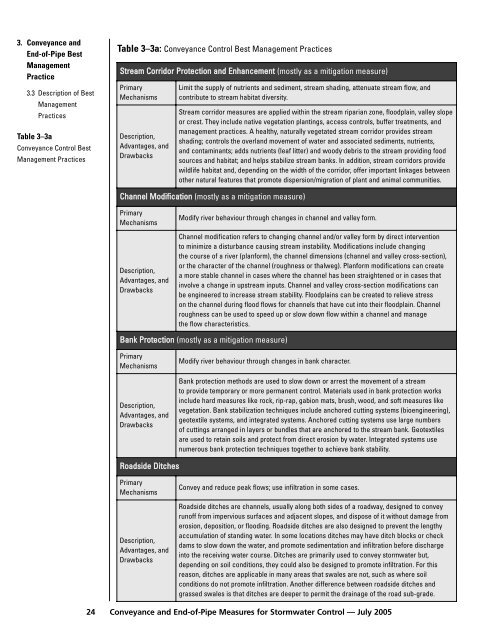Conveyance and End-of-Pipe Measures for Stormwater - FCM
Conveyance and End-of-Pipe Measures for Stormwater - FCM
Conveyance and End-of-Pipe Measures for Stormwater - FCM
Create successful ePaper yourself
Turn your PDF publications into a flip-book with our unique Google optimized e-Paper software.
3. <strong>Conveyance</strong> <strong>and</strong><br />
<strong>End</strong>-<strong>of</strong>-<strong>Pipe</strong> Best<br />
Management<br />
Practice<br />
3.3 Description <strong>of</strong> Best<br />
Management<br />
Practices<br />
Table 3–3a<br />
<strong>Conveyance</strong> Control Best<br />
Management Practices<br />
Table 3–3a: <strong>Conveyance</strong> Control Best Management Practices<br />
Stream Corridor Protection <strong>and</strong> Enhancement (mostly as a mitigation measure)<br />
Primary<br />
Mechanisms<br />
Description,<br />
Advantages, <strong>and</strong><br />
Drawbacks<br />
Limit the supply <strong>of</strong> nutrients <strong>and</strong> sediment, stream shading, attenuate stream flow, <strong>and</strong><br />
contribute to stream habitat diversity.<br />
Stream corridor measures are applied within the stream riparian zone, floodplain, valley slope<br />
or crest. They include native vegetation plantings, access controls, buffer treatments, <strong>and</strong><br />
management practices. A healthy, naturally vegetated stream corridor provides stream<br />
shading; controls the overl<strong>and</strong> movement <strong>of</strong> water <strong>and</strong> associated sediments, nutrients,<br />
<strong>and</strong> contaminants; adds nutrients (leaf litter) <strong>and</strong> woody debris to the stream providing food<br />
sources <strong>and</strong> habitat; <strong>and</strong> helps stabilize stream banks. In addition, stream corridors provide<br />
wildlife habitat <strong>and</strong>, depending on the width <strong>of</strong> the corridor, <strong>of</strong>fer important linkages between<br />
other natural features that promote dispersion/migration <strong>of</strong> plant <strong>and</strong> animal communities.<br />
Channel Modification (mostly as a mitigation measure)<br />
Primary<br />
Mechanisms<br />
Description,<br />
Advantages, <strong>and</strong><br />
Drawbacks<br />
Modify river behaviour through changes in channel <strong>and</strong> valley <strong>for</strong>m.<br />
Channel modification refers to changing channel <strong>and</strong>/or valley <strong>for</strong>m by direct intervention<br />
to minimize a disturbance causing stream instability. Modifications include changing<br />
the course <strong>of</strong> a river (plan<strong>for</strong>m), the channel dimensions (channel <strong>and</strong> valley cross-section),<br />
or the character <strong>of</strong> the channel (roughness or thalweg). Plan<strong>for</strong>m modifications can create<br />
a more stable channel in cases where the channel has been straightened or in cases that<br />
involve a change in upstream inputs. Channel <strong>and</strong> valley cross-section modifications can<br />
be engineered to increase stream stability. Floodplains can be created to relieve stress<br />
on the channel during flood flows <strong>for</strong> channels that have cut into their floodplain. Channel<br />
roughness can be used to speed up or slow down flow within a channel <strong>and</strong> manage<br />
the flow characteristics.<br />
Bank Protection (mostly as a mitigation measure)<br />
Primary<br />
Mechanisms<br />
Description,<br />
Advantages, <strong>and</strong><br />
Drawbacks<br />
Roadside Ditches<br />
Primary<br />
Mechanisms<br />
Description,<br />
Advantages, <strong>and</strong><br />
Drawbacks<br />
Modify river behaviour through changes in bank character.<br />
Bank protection methods are used to slow down or arrest the movement <strong>of</strong> a stream<br />
to provide temporary or more permanent control. Materials used in bank protection works<br />
include hard measures like rock, rip-rap, gabion mats, brush, wood, <strong>and</strong> s<strong>of</strong>t measures like<br />
vegetation. Bank stabilization techniques include anchored cutting systems (bioengineering),<br />
geotextile systems, <strong>and</strong> integrated systems. Anchored cutting systems use large numbers<br />
<strong>of</strong> cuttings arranged in layers or bundles that are anchored to the stream bank. Geotextiles<br />
are used to retain soils <strong>and</strong> protect from direct erosion by water. Integrated systems use<br />
numerous bank protection techniques together to achieve bank stability.<br />
Convey <strong>and</strong> reduce peak flows; use infiltration in some cases.<br />
Roadside ditches are channels, usually along both sides <strong>of</strong> a roadway, designed to convey<br />
run<strong>of</strong>f from impervious surfaces <strong>and</strong> adjacent slopes, <strong>and</strong> dispose <strong>of</strong> it without damage from<br />
erosion, deposition, or flooding. Roadside ditches are also designed to prevent the lengthy<br />
accumulation <strong>of</strong> st<strong>and</strong>ing water. In some locations ditches may have ditch blocks or check<br />
dams to slow down the water, <strong>and</strong> promote sedimentation <strong>and</strong> infiltration be<strong>for</strong>e discharge<br />
into the receiving water course. Ditches are primarily used to convey stormwater but,<br />
depending on soil conditions, they could also be designed to promote infiltration. For this<br />
reason, ditches are applicable in many areas that swales are not, such as where soil<br />
conditions do not promote infiltration. Another difference between roadside ditches <strong>and</strong><br />
grassed swales is that ditches are deeper to permit the drainage <strong>of</strong> the road sub-grade.<br />
24 <strong>Conveyance</strong> <strong>and</strong> <strong>End</strong>-<strong>of</strong>-<strong>Pipe</strong> <strong>Measures</strong> <strong>for</strong> <strong>Stormwater</strong> Control — July 2005
















